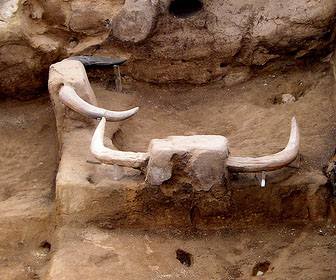| |
Çatalhöyük
is a Neolithic site 25 kilometres south of Konya near Çumra.
The site dates from around the tenth to eighth millenium BC making it
one of the worlds oldest archeological sites. The Neolithic
settlement was discovered in the 1961 by a British archeologist
named James Mellaart.
Evidence of agriculture found has shown that
grains, seeds and nuts were extensively cultivated and animal
husbandry was probably practiced however, hunting was still the
primary source of food.
There is also evidence to suggest that women
may have had an equal role in the leadership of the settlement.
There is little to see at Catalhoyuk.
|

|
|
| |
The site is made up of two flat topped hills and this is from where
it’s name is derived (Çatalhöyük means forked mound in Turkish).
Thirteen different layers have been discovered, the oldest dating
from 6800 BC and the latest from 5500 BC.
Evidence shows that the
rectangular mud brick houses at the site were built crammed together
without being separated by roads or streets and were entered through
holes cut into the roofs.
The houses contain a hearth, oven and
platforms for sleeping, sitting and working. Archeologists have
found wall paintings of animals and also paintings of men being
eaten by vultures. Human bones wrapped in straw have been found in a
burial chamber and heads of animals stuffed with clay have also been
excavated. These are thought to have been trophies. There is also
what is thought to be the worlds first landscape painting showing a
volcano erupting, this could be the nearby Hasan Dağı.
Many small
statues of a mother goddess thought to be related to the Phrygian
goddess Cybele have been discovered, the most interesting of which
are now in the Museum of Anatolian Civilizations in Ankara. The
Neolithic settlement was abandoned before the Bronze Age. A few
hundred metres to the east of the site there is evidence of a
Byzantine settlement.
In 1996 Çatalhöyük was put onto a list of
archeological sites in danger due to disintegrating trenches and
walls but excavations at Çatalhöyük are continuing today under an
international team of archeologists and using the money from
international sponsors. The best time to visit is when excavations
are taking place during the summer months.
How to get there?
To get to Catalhoyuk take a dolmus (shared taxi) from Konya to Çumra and then a
taxi from Çumra to the site. If you have your own transport then the
site is signposted from Çumra.
Çatalhöyük is usually visited as a
daytrip and as such there are no places to stay near the site. It is
best to find accommodation in nearby Konya in hotels such as Hotel
Bera, Hotel Dundar, the three star Balıcılar Hotel or Yeni Sema
Hotel.
|
|
